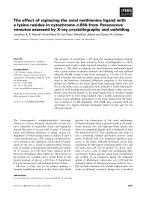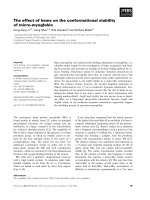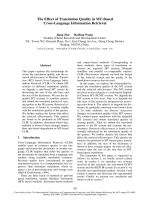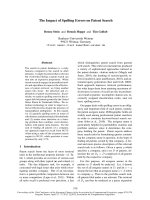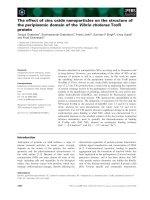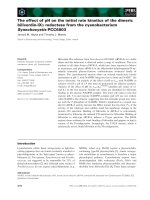Báo cáo khoa học: The effect of HAMP domains on class IIIb adenylyl cyclases from Mycobacterium tuberculosis pptx
Bạn đang xem bản rút gọn của tài liệu. Xem và tải ngay bản đầy đủ của tài liệu tại đây (201.11 KB, 6 trang )
The effect of HAMP domains on class IIIb adenylyl cyclases
from
Mycobacterium tuberculosis
Ju¨ rgen U. Linder, Arne Hammer and Joachim E. Schultz
Abteilung Pharmazeutische, Biochemie Fakulta
¨
tfu
¨
r Chemie und Pharmazie, Universita
¨
tTu
¨
bingen Morgenstelle, Tu
¨
bingen, Germany
The genes Rv1318c, Rv1319c, Rv1320c and Rv3645
1
of
Mycobacterium tuberculosis are predicted to code for four
out of 15 adenylyl cyclases in this pathogen. The proteins
consist of a membrane anchor, a HAMP region and a class
IIIb adenylyl cyclase catalytic domain. Expression and
purification of the isolated catalytic domains yielded aden-
ylyl cyclase activity for all four recombinant proteins.
Expression of the HAMP region fused to the catalytic
domain increased activity in Rv3645 21-fold and slightly
reduced activity in Rv1319c by 70%, demonstrating iso-
form-specific effects of the HAMP domains. Point muta-
tions were generated to remove predicted hydrophobic
protein surfaces in the HAMP domains. The mutations
further stimulated activity in Rv3645 eight-fold, whereas the
effect on Rv1319c was marginal. Thus HAMP domains can
act directly as modulators of adenylyl cyclase activity. The
modulatory properties of the HAMP domains were con-
firmed by swapping them between Rv1319c and Rv3645.
The data indicate that in the mycobacterial adenylyl cyclases
the HAMP domains do not display a uniform regulatory
input but instead each form a distinct signaling unit with its
adjoining catalytic domain.
Keywords: adenylyl cyclase; HAMP-domain; Mycobac-
terium tuberculosis.
Synthesis of the universal second messenger cAMP is
accomplished by a plethora of adenylyl cyclases (ACs)
which are currently arranged in five classes of unrelated
primary structure [1–3]. The vast majority of ACs fall into
class III which in turn has been subdivided recently into four
subclasses (IIIa–d, [4]). The catalytic domain of these ACs,
also designated as the cyclase homology domain (CHD), is
often linked with further protein domains which in general
appear to be regulators of cAMP production. For example,
GAF, BLUF, histidine kinase, receiver, RAS-associating
and cation channel domains have been found in conjunction
with the class III AC catalytic domain [4]. A prominent
illustration of AC diversity occurs in the human pathogen
Mycobacterium tuberculosis with 15 predicted class III ACs,
two of class IIIa, four of class IIIb and nine of class IIIc
[4,5]. Fusion partners of the mycobacterial CHDs include
membrane anchors, a novel autoinhibitory domain, AAA-
ATPase domains, helix-turn-helix DNA-binding domains,
an a/b-hydrolase domain and HAMP-domains. So far only
two mycobacterial ACs have been reported to be enzymat-
ically active, Rv1625c (class IIIa) and Rv1264 (class IIIc)
[6–8].
Here we report on the four class IIIb ACs from
M. tuberculosis H37Rv (Rv1318c, Rv1319c, Rv1320c,
Rv3645) which contain a single HAMP domain as part
of an 8 kDa region which connects the CHD to a 31 kDa
membrane anchor with six predicted transmembrane spans
(Fig. 1A). HAMP-domains [abbreviation originating from
their primary occurance in histidine kinase, adenylyl cyclase,
methyl accepting chemotaxis proteins (MCPs) and phos-
phatases] are amphiphilic protein regions of about 50 amino
acids which are predicted to fold into two amphipathic
a-helices joined by a short linker [9]. The exact physical
structure of HAMP still awaits elucidation [9]. The
biochemical function of the HAMP domain has been
investigated exclusively in receptor histidine kinases and in
MCPs [9–13]. Mutagenesis studies with the Escherichia coli
Aer protein, an aerotactic MCP, suggest an interaction of
a HAMP domain with a flavin adenine dinucleotide-binding
PAS-domain (acronym for period clock protein, aryl
hydrocarbon receptor, single-minded protein) [13]. Further,
it has been speculated that HAMP domains may function as
an autonomous switch between two signaling states, or that
they may regulate receptor histidine kinases by formation of
four-helix bundles with a downstream dimerization domain
[9,10]. Yet, respective experiments with the HAMP domains
of the related sensor kinases NarX and NarQ resulted in
completely different phenotypes, e.g. a deletion of seven
amino acids yielded a constitutively active NarX while the
same mutation did not affect the regulation of NarQ [11].
Thus, it must be acknowledged that minor variations
among HAMP-domain primary structures may result in
rather individual structure-function relationships including
crosstalk between HAMP-domains and their adjoining
effector modules [11].
Correspondence to J. U. Linder, Abteilung Pharmazeutische Bioche-
mie, Fakulta
¨
tfu
¨
r Chemie und Pharmazie, Universita
¨
tTu
¨
bingen,
Morgenstelle 8, 72076 Tu
¨
bingen, Germany, Fax: + 49 7071 295952,
Tel.: + 49 7071 2974676, E-mail:
Abbreviations: AC, adenylyl cyclase; CHD, cyclase homology domain;
MCP, methyl accepting chemotaxis protein.
Enzyme: adenylyl cyclase (EC 4.6.1.1).
(Received 25 February 2004, revised 8 April 2004,
accepted 19 April 2004)
Eur. J. Biochem. 271, 2446–2451 (2004) Ó FEBS 2004 doi:10.1111/j.1432-1033.2004.04172.x
Here we investigated the HAMP domain function in the
context of mycobacterial class IIIb ACs. The isolated CHDs
of all four isoforms were purified and had AC activity
in vitro. Inclusion of the N-terminal HAMP-region
enhanced the activity of the CHD of Rv3645 by more than
an order of magnitude. Disruption of the predicted hydro-
phobic epitopes of the HAMP-domain enhanced substrate
affinity about eightfold, in principle demonstrating the
ability of the HAMP domain region to regulate AC activity.
The effect of the HAMP domain on the CHD of Rv1319c
was much less pronounced, supporting the earlier notion
of a distinct individuality of the interactions of HAMP-
domains within a particular protein.
Experimental procedures
Materials
Genomic DNA from M. tuberculosis was a gift from E. C.
Boettger
2
,UniversityofZu
¨
rich Medical School. Radio-
chemicals were from Hartmann Analytik (Braunschweig,
Germany). All enzymes were purchased from either
Roche Diagnostics or New England Biolabs. pQE30 and
Ni-nitrilotriacetic acid–agarose were from Qiagen. Fine
chemicals were from Merck KGaA, Roche Diagnostics,
Roth and Sigma (Germany).
Plasmid construction
The open reading frames of genes Rv1318c, Rv1319c,
Rv1320c (GenBank Accession Number BX842576) and
Rv3645 (GenBank Accession Number NC_000962) were
amplified by PCR using specific primers and genomic DNA
as a template. HindIII sites were added at the 3¢-ends,the
5¢-ends were fitted with BglII sites (Rv1318c, Rv3645)or
BamHI sites (Rv1319c, Rv1320c). The open reading frames
were cloned between the BamHI and HindIII sites of
pQE30, adding an N-terminal MRGSH
6
GS-tag. Partial
constructs comprised the following amino acids: Rv1318c-
CHD, 355–541; Rv1319c-CHD, 356–535; Rv1320c-CHD,
355–567; Rv3645-CHD, 356–549; Rv1319c-HAMP-CHD,
279–535; Rv3645-HAMP-CHD, 279–549. BamHI and
HindIII sites were added at the 5¢-and3¢-ends, respectively,
and the fragments were cloned into pQE30. The following
point mutations were introduced simultaneously by PCR
using the expression cassettes as a template, a silent BglII
site engineered at nucleotide 996 of both, Rv1319c and
Rv3645, and standard molecular biology techniques:
V284N, V294S, L311N, F318S, V322N in Rv1319c;
I280T, L284N, V294S, L311N, F318S, V322N in Rv3645.
The silent BglII site was also used for construction of
chimeras in which the HAMP-domains (amino acids 279–
332) were swapped between Rv1319c and Rv3645.For
constructs containing only the 23 amino acids long linker
between HAMP and the CHD, i.e. amino acids 333–535
of Rv1319c and 333–567 of Rv3645, the respective BglII/
HindIII fragments were cloned into pQE31, adding an
N-terminal MRGSH
6
T-tag (Fig. 1B for definition of
sequence segments). The correctness of all DNA inserts
was checked by double-stranded DNA sequencing. Primer
sequences are available on request.
Expression and purification of proteins
Expression plasmids were transformed into E. coli
BL21(DE3)[pRep4]. Expression was induced by 60 l
M
isopropyl thio-b-
D
-galactoside for 4–6 h at 22 °C. Bacteria
were washed with buffer (50 m
M
Tris/HCl, 1 m
M
EDTA,
pH 8), frozen in liquid nitrogen and stored at )80 °C. For
purification, cells from 200 to 600 mL culture were suspen-
ded in 20 mL of lysis buffer (50 m
M
Tris/HCl, 2 m
M
3-thioglycerol, pH 8), lysed by sonication for 30 s and
Fig. 1. Sequence analysis of mycobacterial Rv1318c, Rv1319c, Rv1320c and Rv3645 genes. (A) Domain composition of class IIIb ACs from
M. tuberculosis. Hatched rectangles depict predicted transmembrane helices. Note the fusion of the last transmembrane helix to the HAMP
domain. (B) Sequence alignment of the HAMP regions. Residues similar in all sequences are inverted. TM 6, transmembrane helix 6. Me, a metal-
cofactor binding aspartate residue is marked for orientation purposes. Chim., cross-over site for the construction of chimeras. The predicted
secondary structure of two a-helices is indicated by lightly shaded boxes on top.
Ó FEBS 2004 M. tuberculosis HAMP-adenylyl cyclases (Eur. J. Biochem. 271) 2447
treatedfor30minwith0.2mgÆmL
)1
lysozyme on ice.
Subsequently, 5 m
M
MgCl
2and
10 lgÆmL
)1
DNaseI were
added for further 30 min on ice. After centrifugation
(31 000 g,30min)15m
M
imidazole, pH 8, and 250 m
M
NaCl (final concentrations) were added to the supernatant.
Protein was equilibrated for a minimum of 60 min with
250 lLNi
2+
-nitrilotriacetic acid–agarose
3
on ice, then
transferred to a column and successively washed with
10 mL of buffer A (lysis buffer containing, 15 m
M
imidaz-
ole, 250 m
M
NaCl and 5 m
M
MgCl
2
) and 5 mL of buffer B
(lysis buffer containing 15 m
M
imidazole and 5 m
M
MgCl
2
).
The protein was eluted with 0.4 mL of buffer C (37.5 m
M
Tris/HCl,pH8,250m
M
imidazole, 2 m
M
MgCl
2,
1.5 m
M
3-thioglycerol). Purified proteins were stored at )20 °Cin
buffer C after addition 20% of glycerol to the eluate.
For membrane preparations of cells expressing the
holoenzymes, lysis was performed by a French Press. Cell
debris was removed at 3000 g for 30 min and membranes
were sedimented at 100 000 g for 1 h at 0 °C. Membranes
were suspended in buffer (40 m
M
Tris/HCl, pH 8.0, 1.6 m
M
3-thioglycerol, 20% glycerol) and assayed for AC activity.
Cells transformed with pQE30 served as a negative control.
Adenylyl cyclase assays
AC activity was determined at 37 °Cfor10minin100lL
[14]. Standard reactions contained 50 m
M
Tris/HCl,
pH 8.0, 22% glycerol, 3 m
M
MnCl
2
,200l
M
[
32
P]ATP[aP]
and 2 m
M
[2,8-
3
H]cAMP. For kinetic analysis, variable
amounts of MnATP were used in the presence of 3 m
M
free Mn
2+
. At least two independent purifications were
performed for recombinant protein. All data are means of
4–11 measurements ± SD.
Results
Sequence features of mycobacterial class IIIb ACs
The predicted gene products of Rv1318c, Rv1319c, Rv1320c
and Rv3645 from M. tuberculosis H37Rv would be members
of the class IIIb AC family. Characteristics of class IIIb ACs
include the substitution of a threonine for the canonical
substrate-specifying aspartate and an arm region extended
by one residue compared to class IIIa ACs (e.g. mycobac-
terial Rv1625c, mammalian membrane-bound ACs [4]).
The N-terminal of all four mycobacterial ACs is predicted
to constitute a membrane anchor with six transmembrane
helices (Fig. 1A). The last transmembrane helix is fused
directly to a HAMP-domain which is part of the region
connecting the membrane anchor to the catalytic domain
(CHD). Secondary structure prediction suggested that
the second amphipathic helix of the HAMP domain is
C-terminally extended by about 20 amino acids (Fig. 1B)
which implies that HAMP is embedded in a larger structural
module. The CHDs of the mycobacterial class IIIb ACs are
predicted to form homodimers with two catalytic centers at
the dimer interface, as has been demonstrated for several
other bacterial ACs [4].
The overall amino acid identities within the cluster of
Rv1318c–Rv1320c are 67–77%, the identities of these three
cyclases with Rv3645 are 37–38%. Higher identities are
observed among the CHDs (76–79% within the cluster,
53–57% to Rv3645) and the HAMP regions (87–91%
within the cluster, 46–47% to Rv3645).
Expression of the isolated catalytic domains
All four catalytic domains which start 11 amino acids
upstream of the first metal-binding aspartate ([8,15]) were
overexpressed in E. coli and purified essentially to homo-
geneity via an N-terminal His
6
metal-affinity tag (Fig. 2,
lanes 1–4). All proteins possessed significant enzymatic
activity in the presence of 3 m
M
Mn
2+
as a cofactor,
demonstrating that the four genes code for functional ACs.
All enzymes were specific for ATP as a substrate. Tiny
guanylyl cyclase side-activities were detectable in Rv1319c-
CHD ( 0.08 nmol cGMPÆmg
)1
Æmin
)1
) and Rv3645-CHD
( 0.03 nmol cGMPÆmg
)1
Æmin
)1
).
For a further kinetic characterization, we selected the two
most active enzymes, Rv1319c-CHD and Rv3645-CHD
(Table 1). The maximal velocity of both enzymes was rather
similar, yet Rv1319c-CHD had 20-fold higher affinity for
the substrate, ATP than Rv3645-CHD (Table 1). The Hill
coefficients of 1.0 indicated that the two predicted catalytic
centers did not interact cooperatively in the recombinant
CHDs. The large difference in substrate affinity between the
isoforms and the known differences of metal-cofactor
affinity of mammalian AC isoforms [16] prompted us to
investigate the metal-cofactor dependence in detail. Nota-
bly, Mg
2+
was ineffective as a cofactor. At 25 m
M
Mg
2+
Rv1319c-CHD had 3% of the activity with 3 m
M
Mn
2+
,
Rv3645-CHD was inactive with Mg
2+
.Mn
2+
affinities
(EC
50
values) were 0.48 ± 0.02 and 3.9 ± 0.3 m
M
for
Rv1319c-CHD and Rv3645-CHD, respectively. Thus the
Fig. 2. 15% SDS/PAGE of affinity-purified AC proteins. Enzyme (1.5–
2.1 lg per lane) were stained with Coomassie blue. AC activities ± SD
at 2.2–3.5 l
M
enzyme under standard conditions are given below each
lane. Lane 1, Rv1318c-CHD; lane 2, Rv1319c-CHD; lane 3, Rv1320c-
CHD; lane 4, Rv3645-CHD; lane 5, Rv1319c-HAMP-CHD; lane 6,
Rv1319c-HAMP
mut
-CHD; lane 7, Rv3645-HAMP-CHD; lane 8,
Rv3645-HAMP
mut
-CHD; lane 9, Rv3645HAMP-1319cCHD; lane 10,
1319cHAMP-3645CHD. Note, that the apparent molecular mass of
Rv1318c-CHD, Rv1320c-CHD Rv3645c-CHD appears about 3 kDa
higher than calculated. We attribute this slight deviation to unusual
electrophoretic mobility as often observed. Rv1319c-CHD runs
canonically. An extended translation is highly unlikely, because all
constructs were completely sequenced and contain two in-frame stop
codons.
2448 J. U. Linder et al. (Eur. J. Biochem. 271) Ó FEBS 2004
differences in substrate affinity parallel those for Mn
2+
-
affinity.
Modulation of AC activity by the HAMP-domain
To examine a possible regulatory input of the HAMP
domain on AC activity, we expressed constructs comprising
the CHD and the HAMP-region, i.e. Rv1319c-HAMP-
CHD and Rv3645-HAMP-CHD. The purified proteins
displayed altered cyclase activities compared to the respect-
ive catalysts alone (Fig. 2, lanes 5, 7). In Rv1319c the
attached HAMP region reduced activity by 70% whereas
the activity of the CHD of Rv3645 was enhanced 21-fold.
As a control we expressed and purified constructs in which
only the 23 amino acid linker was present N-terminally of
the respective CHD. The recombinant proteins had the
same activity as the CHDs alone. This suspends the
possibility that the slightly diverged linkers alone influence
the activities of Rv1319c-HAMP-CHD and Rv3645-
HAMP-CHD (data not shown). A kinetic analysis revealed
that the reduced activity in Rv1319c-HAMP-CHD was
due to a simultaneous reduction of V
max
and the
substrate-affinity (Table 1) whereas the increased activity
of Rv3645-HAMP-CHD was due to a higher V
max
with a
slightly reduced substrate affinity (Table 1). In general the
presence of the HAMP region actuated a certain extent of
cooperativity between the two catalytic centers (Table 1).
Taken together it appears that the HAMP regions modulate
the AC activity of the CHDs in a rather distinct manner.
Next we examined the role of the HAMP region by
targeting its amphiphilic nature. Helical wheel representa-
tions of the HAMP-domains indicate hydrophobic surfaces
in both helices of the two isoforms (Fig. 3). To weaken
hydrophobic interactions between these surfaces, we simul-
taneously replaced hydrophobic residues in both helices of
Rv1319c and Rv3645 by amino acids with hydrophilic
uncharged side chains (Fig. 3). The recombinant proteins,
Rv1319c-HAMP
mut
-CHD and Rv3645-HAMP
mut
-CHD,
were purified and assayed. In Rv1319c, the mutations
increased AC activity of the HAMP-CHD ensemble to
195% of the respective unaltered construct (Fig. 2, com-
pare lanes 5 and 6). In Rv3645, removal of the hydro-
phobic surface of the HAMP region caused a sevenfold
increase of activity (Fig. 2, lanes 7, 8), rendering
Table 1. Kinetic properties of protein constructs for Rv1319c and Rv3645. Concentrations of affinity-purified, homogenous proteins were 1–5 l
M
to
limit substrate conversion to < 10%. SC
50
, substrate concentration at half-maximal velocity.
Enzyme
V
max
(nmol cAMPÆmg
)1
Æmin
)1
)
SC
50
(l
M
) Hill-coefficient
Rv1319c-CHD 6.6 ± 0.1 57 ± 1 1.0 ± 0.04
Rv1319c-HAMP-CHD 3.6 ± 0.1 150 ± 3 1.2 ± 0.1
Rv1319c-HAMP
mut
-CHD 6.1 ± 0.3 110 ± 8 1.0 ± 0.1
3645HAMP-1319cCHD 8.6 ± 0.1 180 ± 5 1.3 ± 0.03
Rv3645-CHD 8.2 ± 0.6 1200 ± 100 1.0 ± 0.03
Rv3645-HAMP-CHD 590 ± 10 2700 ± 100 1.4 ± 0.01
Rv3645-HAMP
mut
-CHD 470 ± 30 380 ± 50 1.3 ± 0.1
1319cHAMP-3645CHD 79 ± 2 2600 ± 200 1.3 ± 0.02
Fig. 3. Helical wheel models of the HAMP-
domains. Hydrophobic residues (L, I, M, V, F,
A, P) are inverted, nonhydrophobic ones are
lightly shaded. Letters and arrows denote the
mutations introduced to eliminate hydro-
phobic surfaces.
Ó FEBS 2004 M. tuberculosis HAMP-adenylyl cyclases (Eur. J. Biochem. 271) 2449
Rv3645-HAMP
mut
-CHD 100-fold more active than the
isolated CHD (Fig. 2 compare lanes 4 and 8). Thus the
hydrophobic epitopes of the HAMP-domain appear to act
like a throttle on AC activity, their disruption enhances the
catalytic efficiency. A kinetic analysis revealed that Rv3645-
HAMP
mut
-CHD had an eightfold higher substrate-affinity
compared to Rv3645-HAMP-CHD (Table 1).
Do the differences in the effects of the HAMP domains
reside in particular features of the respective ensemble or are
they intrinsic properties of the respective HAMP domains?
To answer this question we swapped the HAMP domains
and generated 3645HAMP-1319cCHD and 1319cHAMP-
3645CHD, respectively (Fig. 1B). Under standard assay
conditions, the activity of Rv1319c was repressed by the
Rv3645 HAMP domain by 38%, i.e. slightly less than the
70% by the wild-type module (Rv1319c-HAMP-CHD,
Fig. 2, compare lanes 2, 5 and 9). The Rv1319c HAMP
domain stimulated Rv3645 only threefold compared to the
21-fold stimulation seen in Rv3645-HAMP-CHD (Fig. 2,
compare lanes 4, 7 and 10). The kinetic parameters
confirmed that the external HAMP domain affected
catalysis of Rv3645 similarly as the intrinsic HAMP
domain, i.e. large increase in V
max
, accompanied by a slight
reduction in substrate-affinity (Table 1). However, in
Rv1319c the Rv3645 HAMP domain reduced substrate
affinity threefold and increased V
max
only marginally. With
regard to the above questions this means that it is
predominantly the kind of interaction between catalyst
and regulatory domain which determines the regulatory
output of HAMP domains and not an intrinsic feature of a
peculiar HAMP domain.
As each hydrophilic surface of the HAMP domains
carries 4–5 charged residues (Fig. 3), we tested whether the
cationic amphiphilic antibiotic Gramicidin S interferes with
their function. Gramicidin S (10 l
M
) had no effect on the
constructs of Rv1319c, but it differentially affected Rv3645
constructs. While the activity of Rv3645-CHD remained
unaffected, Gramicidin inhibited Rv3645-HAMP-CHD by
43 ± 4% and Rv3645-HAMP
mut
-CHD by 18 ± 2%.
Thus Gramicidin appeared to impair slightly the interaction
of the HAMP domain of Rv3645 with its catalytic domain.
As Gramicidin also inhibited the Rv3645-HAMP
mut
-CHD
construct somewhat, it may be intimated that it partially
interacted with the hydrophilic surfaces of the HAMP
helices.
Finally, we wished to characterize the effect of the
HAMP domains in the context of the membranous
holoenzymes. Therefore we attempted to express all four
mycobacterial class IIIb AC isoforms. However, significant
AC activity was only seen upon expression of the Rv3645
holoenzyme (1 nmol cAMPÆmg
)1
Æmin
)1
)inisolatedcell
membranes. Solubilization and purification of the holo-
enzyme was impossible due to instability of the enzyme
upon detergent treatment needed for solubilization. This
stymied all attempts to reliably characterize a potential
modulatory effect of the HAMP domain in the holoenzyme.
Discussion
For the first time we show here that the catalytic domains of
all four class IIIb ACs of M. tuberculosis H37Rv (Rv1319c-
1320c, Rv3645) are actually enzymatically active. Although
the multiplicity of these highly similar gene products may
suggest a redundancy of functional class IIIb ACs in
M. tuberculosis, the data show that each cyclase displays
rather individual properties and thus may serve distinctive
cellular demands. Striking differences are exemplified by a
closer analysis of Rv1319c and Rv3645. Rv1319c has a
20-fold higher substrate affinity than Rv3645 while the
effect of the HAMP region is much more dramatic in
Rv3645. Even within the cluster of Rv1318c–Rv1320c AC
activities vary by one order of magnitude, supporting the
suggestion that their physiological role may be tailored to
particular cellular states and needs during the survival of the
pathogen under changing environmental conditions in the
host.
The AC activities of these class IIIb CHDs are two orders
of magnitude lower than those published for the CHDs of
the mycobacterial ACs Rv1625c (class IIIa) and Rv1264
(class IIIc) [7,8]. In our view, this does not imply that the
class IIIb ACs are of minor importance or physiologically
irrelevant, because catalysis of Rv3645 can be potentiated
by the HAMP region, yielding V
max
values of comparable
magnitude as Rv1625c and Rv1264 [7,8]. In all likelihood,
the Rv1318c-1320c isoforms will also be regulated in such
an individual manner although the mechanisms remain
enigmatic.
The four ACs require Mn
2+
for efficient catalysis. This
has also been reported for the mycobacterial ACs Rv1625c
[6,7] and Rv1264 [8] and we observe the same with four
further mycobacterial ACs currently under investigation
(Rv0386, Rv1647, lipJ, Rv2212). The Mn
2+
-dependence of
the ACs suggests that millimolar concentrations of Mn
2+
are physiological in M. tuberculosis as it has been discussed
previously [6]. The cytosolic concentration of Mn
2+
in
Mycobacterium is unknown. Yet, the presence of a high-
affinity Mn
2+
-transporter in M. tuberculosis supports this
suggestion [17]. Furthermore Lactobacillus plantarum is
known to contain 16–25 m
M
Mn
2+
in the cytosol [18]
demonstrating that some bacteria indeed accumulate
Mn
2+
to high concentrations.
An interesting question concerns the role of the HAMP-
region and the membrane anchors in AC regulation. So far,
HAMP domains coupled in a similar manner with AC
catalysts have been detected in the genomes of a variety of
bacteria, such as Corynebacteria, Legionella, Leptospira and
Treponema. However, a biochemical study has not been
carried out with any of those potential gene products. In
Rv1319c the HAMP region exerts a slightly inhibitory effect
on the CHD and in Rv3645 it has a large stimulatory effect
indicating that obviously no general rule can be deduced
from our data for the effect of HAMP domains on AC
catalysts. Even more striking, the disruption of the predicted
hydrophobic surfaces in the Rv3645 HAMP domain itself
caused a large increase in catalytic efficiency. Thus, HAMP
domains can act as a regulatory module on the CHD
independently of the presence of the N-terminal membrane
anchor. A crucial involvement of the hydrophobic epitopes
in signaling through HAMP has been predicted earlier [10].
Our experiments indicate that hydrophobic interactions in
or with the HAMP domains affect the activity status. As for
the effect of Gramicidin S on the HAMP domain function
of Rv3645 we speculate that the AC is regulated in vivo by
an as yet unknown factor that may directly and reversibly
2450 J. U. Linder et al. (Eur. J. Biochem. 271) Ó FEBS 2004
interact with HAMP domains. Such an interaction of a
HAMP domain with another module has been demonstra-
ted previously for the oxygen sensor protein Aer from
E. coli, where an intramolecular interaction between the
HAMP domain and the PAS domain is observed [13].
The role of the membrane anchors in signaling through
HAMP domains remains enigmatic. The close attachment
of the HAMP domains to the last transmembrane span is a
structural feature shared by MCPs and receptor histidine
kinases [19]. Therefore the membrane anchors may serve as
external sensors of physical or chemical stimuli which are
then transmitted via a sophisticated system for cAMP
generation, possibly spatially and temporally fine-tuned by
the multiplicity of AC isoforms. In fact, the membrane
anchors are the most divergent parts of the four mycobac-
terial HAMP-ACs studied here and in different M. tuber-
culosis strains the number of HAMP-ACs varies. The
cluster of three ACs (Rv1318c)1320c) in strain H37Rv
corresponds to a cluster of four genes (MT1359–1362)in
strain CDC1551 [20]. The MT1361 protein corresponds to
Rv1319c (99% identity). MT1360 has a membrane anchor
which is diverged by 43% compared to Rv1319c whereas
the HAMP-CHD ensemble is identical to that of Rv1319c.
This again suggests that the membrane anchor of
each isoform has evolved towards a specific, yet elusive
function.
The physiological role of the four mycobacterial class IIIb
ACs is as yet unknown. Our biochemical studies, which may
be termed genomics-based biochemistry, reveal new and
valuable aspects of the function of HAMP-domains in
general. HAMP domains appear to have regulatory func-
tions of their own in addition to a role as signal transducers.
The HAMP-CHD ensembles of the mycobacterial class IIIb
ACs reported here may be the first step toward an
establishment of the mechanistic relationship between the
HAMP domain and its attached AC catalysts.
References
1. Barzu, O. & Danchin, A. (1994) Adenylyl cyclases: a hetero-
geneous class of ATP-utilizing enzymes. Prog. Nucleic Acid. Res.
Mol. Biol. 49, 241–283.
2. Cotta, M.A., Whitehead, T.R. & Wheeler, M.B. (1998) Identifi-
cation of a novel adenylate cyclase in the ruminal anaerobe, Pre-
votella ruminicola D31d. FEMS Microbiol. Lett. 164, 257–260.
3. Sismeiro, O., Trotot, P., Biville, F., Vivares, C. & Danchin, A.
(1998) Aeromonas hydrophila adenylyl cyclase 2: a new class of
adenylyl cyclases with thermophilic properties and sequence
similarities to proteins from hyperthermophilic archaebacteria.
J. Bacteriol. 180, 3339–3344.
4. Linder, J.U. & Schultz, J.E. (2003) The class III adenylyl cyclases:
multi-purpose signalling modules. Cell. Signal. 15, 1081–1089.
5. McCue, L.A., McDonough, K.A. & Lawrence, C.E. (2000)
Functional classification of cNMP-binding proteins and nucleo-
tide cyclases with implications for novel regulatory pathways in
Mycobacterium tuberculosis. Genome Res. 10, 204–219.
6. Reddy,S.K.,Kamireddi,M.,Dhanireddy,K.,Young,L.,Davis,
A. & Reddy, P.T. (2001) Eukaryotic-like adenylyl cyclases in
Mycobacterium tuberculosis H37Rv: cloning and characterization.
J. Biol. Chem. 276, 35141–35149.
7. Guo, Y.L., Seebacher, T., Kurz, U., Linder, J.U. & Schultz, J.E.
(2001) Adenylyl cyclase Rv1625c of Mycobacterium tuberculosis:
a progenitor of mammalian adenylyl cyclases. EMBO J. 20,
3667–3675.
8. Linder, J.U., Schultz, A. & Schultz, J.E. (2002) Adenylyl cyclase
Rv1264 from Mycobacterium tuberculosis has an autoinhibitory
N-terminal domain. J. Biol. Chem. 277, 15271–15276.
9. Aravind, L. & Ponting, C.P. (1999) The cytoplasmic helical linker
domain of receptor histidine kinase and methyl-accepting proteins
is common to many prokaryotic signalling proteins. FEMS
Microbiol. Lett. 176, 111–116.
10. Williams, S.B. & Stewart, V. (1999) Functional similarities
among two-component sensors and methyl-accepting chemotaxis
proteins suggest a role for linker region amphipathic helices in
transmembrane signal transduction. Mol. Microbiol. 33, 1093–
1102.
11. Appleman, J.A., Chen, L.L. & Stewart, V. (2003) Probing con-
servation of HAMP linker structure and signal transduction
mechanism through analysis of hybrid sensor kinases. J. Bacteriol.
185, 4872–4882.
12. Appleman, J.A. & Stewart, V. (2003) Mutational analysis of a
conserved signal-transducing element: the HAMP linker of the
Escherichia coli nitrate sensor NarX. J. Bacteriol. 185, 89–97.
13. Bibikov, S.I., Barnes, L.A., Gitin, Y. & Parkinson, J.S. (2000)
Domain organization and flavin adenine dinucleotide-binding
determinants in the aerotaxis signal transducer Aer of Escherichia
coli. Proc. Natl Acad. Sci. USA. 97, 5830–5835.
14. Salomon, Y., Londos, C. & Rodbell, M. (1974) A highly sensitive
adenylate cyclase assay. Anal. Biochem. 58, 541–548.
15. Kanacher, T., Schultz, A., Linder, J.U. & Schultz, J.E. (2002)
A GAF-domain-regulated adenylyl cyclase from Anabaena is a
self-activating cAMP switch. EMBO J. 21, 3672–3680.
16. Pieroni, J.P., Harry, A., Chen, J., Jacobowitz, O., Magnusson,
R.P. & Iyengar, R. (1995) Distinct characteristics of the basal
activities of adenylyl cyclases 2 and 6. J. Biol. Chem. 270, 21368–
21373.
17. Vidal, S.M., Malo, D., Vogan, K., Skamene, E. & Gros, P. (1993)
Natural resistance to infection with intracellular parasites: iso-
lation of a candidate for Bcg. Cell 73, 469–485.
18. Archibald, F.S. & Fridovich, I. (1981) Manganese and defenses
against oxygen toxicity in Lactobacillus plantarum. J. Bacteriol.
145, 442–451.
19. Galperin, M.Y., Nikolskaya, A.N. & Koonin, E.V. (2001) Novel
domains of the prokaryotic two-component signal transduction
systems. FEMS Microbiol. Lett. 203, 11–21.
20. Fleischmann, R.D., Alland, D., Eisen, J.A., Carpenter, L., White,
O., Peterson, J., DeBoy, R., Dodson, R., Gwinn, M., Haft, D.,
et al. (2002) Whole-genome comparison of Mycobacterium
tuberculosis clinical and laboratory strains. J. Bacteriol. 184,
5479–5490.
Ó FEBS 2004 M. tuberculosis HAMP-adenylyl cyclases (Eur. J. Biochem. 271) 2451



